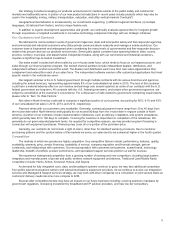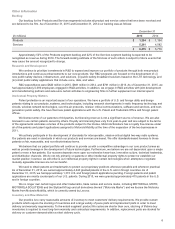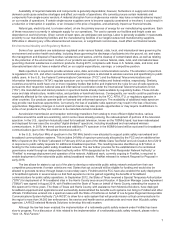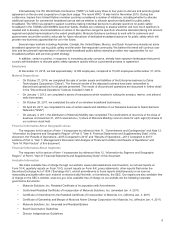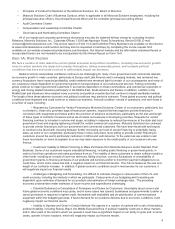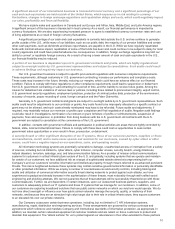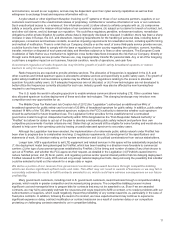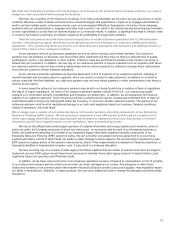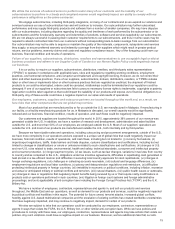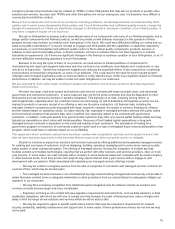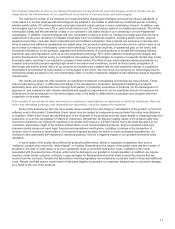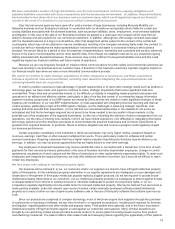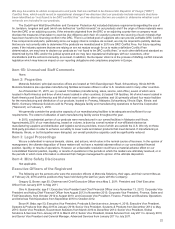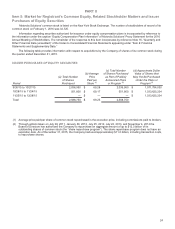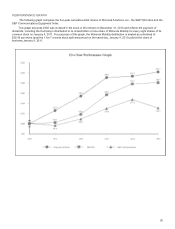Motorola 2015 Annual Report Download - page 16
Download and view the complete annual report
Please find page 16 of the 2015 Motorola annual report below. You can navigate through the pages in the report by either clicking on the pages listed below, or by using the keyword search tool below to find specific information within the annual report.15
We utilize the services of subcontractors to perform under many of our contracts and the inability of our
subcontractors to perform in a timely and compliant manner could negatively impact our ability to comply with our
performance obligations as the prime contractor.
We engage subcontractors, including third-party integrators, on many of our contracts and as we expand our solutions and
services business our use of subcontractors has and will continue to increase. Our subcontractors may further subcontract
performance and may supply third-party products and software from a number of smaller companies. We may have disputes
with our subcontractors, including disputes regarding the quality and timeliness of work performed by the subcontractor or its
subcontractors and the functionality, warranty and indemnities of products, software and services supplied by our subcontractor.
We are not always successful in passing down customer requirements to our subcontractors, and thus in some cases may be
required to absorb contractual risks from our customers without corresponding back-to-back coverage from our subcontractor.
Our subcontractors may not be able to acquire or maintain the quality of the materials, components, subsystems and services
they supply, or secure preferred warranty and indemnity coverage from their suppliers which might result in greater product
returns, service problems, warranty claims and costs and regulatory compliance issues. Any of the foregoing could harm our
business, financial condition and results of operations.
Failure of our suppliers, subcontractors, distributors, resellers and representatives to use acceptable legal or ethical
business practices and adhere to our Supplier Code of Conduct or our Human Rights Policy could negatively impact
our business.
It is our policy to require our suppliers, subcontractors, distributors, resellers, and third-party sales representatives
(“TPSRs”) to operate in compliance with applicable laws, rules and regulations regarding working conditions, employment
practices, environmental compliance, anti-corruption and trademark and copyright licensing. However, we do not control their
labor and other business practices. If one of our suppliers, subcontractors, brokers, distributors, resellers, or TPSRs violates
labor or other laws or implements labor or other business practices that are regarded as unethical, the shipment of finished
products to us could be interrupted, orders could be canceled, relationships could be terminated and our reputation could be
damaged. If one of our suppliers or subcontractors fails to procure necessary license rights to trademarks, copyrights or patents,
legal action could be taken against us that could impact the salability of our products and expose us to financial obligations to a
third-party. Any of these events could have a negative impact on our sales and results of operations.
Our employees, customers, suppliers and outsource partners are located throughout the world and, as a result, we
face risks that other companies that are not global may not face.
Most of our products that are manufactured by or for us outside the U.S. are manufactured in Malaysia. If manufacturing in
our facility, or a facility manufacturing products for us, in Malaysia is disrupted, our overall capacity would be significantly
reduced and our business, financial condition, results of operation, and cash flows could be negatively impacted.
Our customers and suppliers are located throughout the world. In 2015, approximately 39% percent of our revenue was
generated outside the U.S. In addition, we have a number of research and development, administrative and sales facilities
outside the U.S. and more than 50% of our employees are employed outside the U.S. Most of our suppliers' operations are
outside the U.S. and most of our products are manufactured outside the U.S., both internally and by third-parties.
Because we have sizable sales and operations, including outsourcing and procurement arrangements, outside of the U.S.,
we have more complexity in our operations and are exposed to a unique set of global risks that could negatively impact our
business, financial condition, results of operations, and cash flows, including but not limited to: (i) currency fluctuations, (ii)
import/export regulations, tariffs, trade barriers and trade disputes, customs classifications and certifications, including but not
limited to changes in classifications or errors or omissions related to such classifications and certifications, (iii) changes in U.S.
and non-U.S. rules related to trade, environmental, health and safety, technical standards, consumer and intellectual property
and consumer protection, (iv) longer payment cycles, (v) tax issues, such as tax law changes, variations in tax laws from country
to country and as compared to the U.S., obligations under tax incentive agreements, difficulties in repatriating cash generated or
held abroad in a tax-efficient manner and difficulties in securing local country approvals for cash repatriations, (vi) changes in
foreign exchange regulations, (vii) challenges in collecting accounts receivable, (viii) cultural and language differences, (ix)
employment regulations and local labor conditions, (x) privacy and data protection regulations and restrictions, (xi) difficulties
protecting intellectual property in foreign countries, (xii) instability in economic or political conditions, including inflation, recession
and actual or anticipated military or political conflicts and terrorism, (xiii) natural disasters, (xiv) public health issues or outbreaks,
(xv) changes in laws or regulations that negatively impact benefits being received by us or that require costly modifications in
products sold or operations performed in such countries, (xvi) litigation in foreign court systems and foreign administrative
proceedings, and (xvii) applicability of anti-corruption laws including the Foreign Corrupt Practices Act (“FCPA”) and the U.K.
Bribery Act.
We have a number of employees, contractors, representatives and agents in, and sell our products and services
throughout, the Middle East and our operations, as well as demand for our products and services, could be negatively impacted
by political conflicts and hostilities in this region. The potential for future unrest, terrorist attacks, increased global conflicts,
hostility against U.S.-based multinational companies and the escalation of existing conflicts has created worldwide uncertainties
that have negatively impacted, and may continue to negatively impact, demand for certain of our products.
We also are subject to risks that our operations could be conducted by our employees, contractors, representatives or
agents in ways that violate the FCPA, the U.K. Bribery Act, or other similar anti-corruption laws. While we have policies and
procedures to comply with these laws, our employees, contractors, representatives and agents may take actions that violate our
policies. Any such violations could have a negative impact on our business. Moreover, we face additional risks that our anti-


